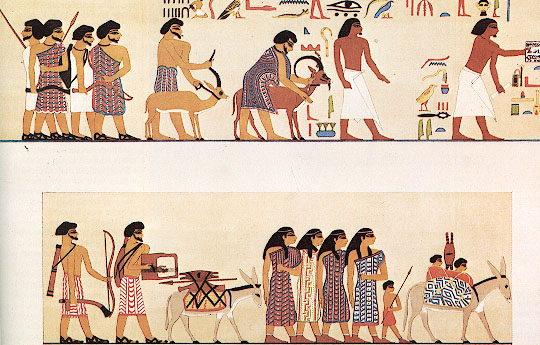RELG 433 - Biblical Archaeology
The EB IV / MB I Period, ca.2,300-2,000 BC
Images in the text are linked to larger photos - click on them to see the larger pictures.
Hover the mouse over the images to see their captions and copyright credits.
 In Canaan
In Canaan
After the collapse of EB III, from causes not known for sure, there was a period of decline. There was some trade with Syria, but not with Egypt.
Settlement Patterns :
Pastoralists and village dwellers, with flocks and herds. No big cities.
Continuing occupation at Hazor, Megiddo, Beth-Shean, Jericho. Megiddo was a small unfortified village.
Other villages at new locations - some on the outskirts of major EB sites.
The main evidence is from cemeteries rather than towns.
- Settlements in central Negev and northern Sinai
Pastoral nomads ? A typical house was one-room, rounded, with a central stone pillar - to support a roof made of stone ?
There were groups or chains of houses.
Nomads - winter in Negev, summer in Shephelah and/or Hebron hills ? - the same type of pottery - East of the Dead Sea
Agrarian sedentary settlements, retaining EB III cultural characteristics : Iktanu, Aroer, Ader, Khirbet Iskander - fortified by massive walls, broad house dwellings - people who fled from EB III troubles ?
Burial Practices :
Large cemeteries. 3 major types of burials, all for individuals or small groups, not for large family groups :
- Shaft tombs
Throughout western Palestine. Dig a pit, then hollow out a chamber at right angles to the shaft. Entrance to chamber sealed with circular stone. Grave goods just a few pots , copper weapons, beads. - Megalithic dolmens
Golan heights and Upper Galilee - basalt blocks. Used for secondary interment of one person. - Built-up tumuli - central Negev, situated on high ridges, or sometimes between houses in a settlement. Often found to be empty - was the body moved elsewhere ?
Pottery :
Three main assemblages - regional :
- Transjordan - East of the Jordan, what is now the Hashemite Kingdom of Jordan - similar to EB III
- Northern - some retention of EB traditions, but distinct from Transjordanian
- Southern
Shapes common to all 3 : goblets, amphoriskoi, teapots, lamps with 4 spouts.
Mainly made by hand rather than on a potter's wheel.
In the North - imported pottery from Syria - teapots and goblets, made on a potter's wheel.
Metallurgy :
Bronze appears for the first time, though most weapons were still made of copper.
- Daggers - developed from EB styles, tang larger, with holes for handle
- Spearheads - short blade, long tang with a hook at the end to prevent shaft splitting.
- Spear butts - long, narrow, sharp, end in a hook.
- Axe-heads - "eye-shaped", with a shaft for the wooden handle.
- The Ain Samiya Goblet - silver, decorated by repoussé technique, found in a shaft grave. The goblet shows two men, in Sumerian style skirts, fat serpents, a mythological creature. It may represent a Mesopotamian myth.
Interpretation :
The common theory is that EB III was ended by the invasion of West-Semitic semi-nomadic tribes from Syria - the "Amurru", also called "Amorites"
 The Beni Hassan tomb painting in Egypt is slightly later than EB IV / MB I, but may represent nomadic Semitic metal-workers coming to Egypt.
The Beni Hassan tomb painting in Egypt is slightly later than EB IV / MB I, but may represent nomadic Semitic metal-workers coming to Egypt.
Albright suggests that this is the time of Abraham and the Patriarchs, moving from Mesopotamia and the north, into Palestine and then to Egypt.
Others suggest Indo-European origins for the settlers / invaders, because of similarities with European dolmens.
Or the changes may be merely due to changed circumstances in the original population, due to the collapse of EB III.
![]()
Copyright © 1999 Shirley J. Rollinson, all Rights Reserved